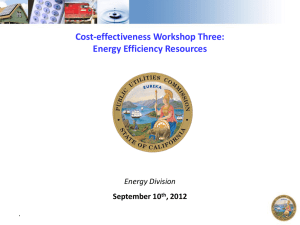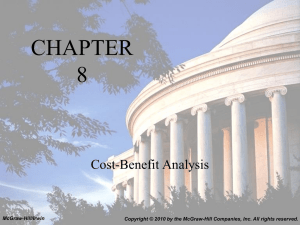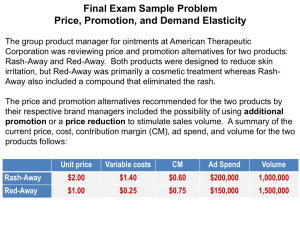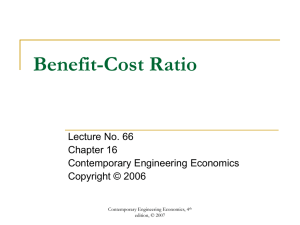Measuring Efficiency - University of South Alabama
advertisement
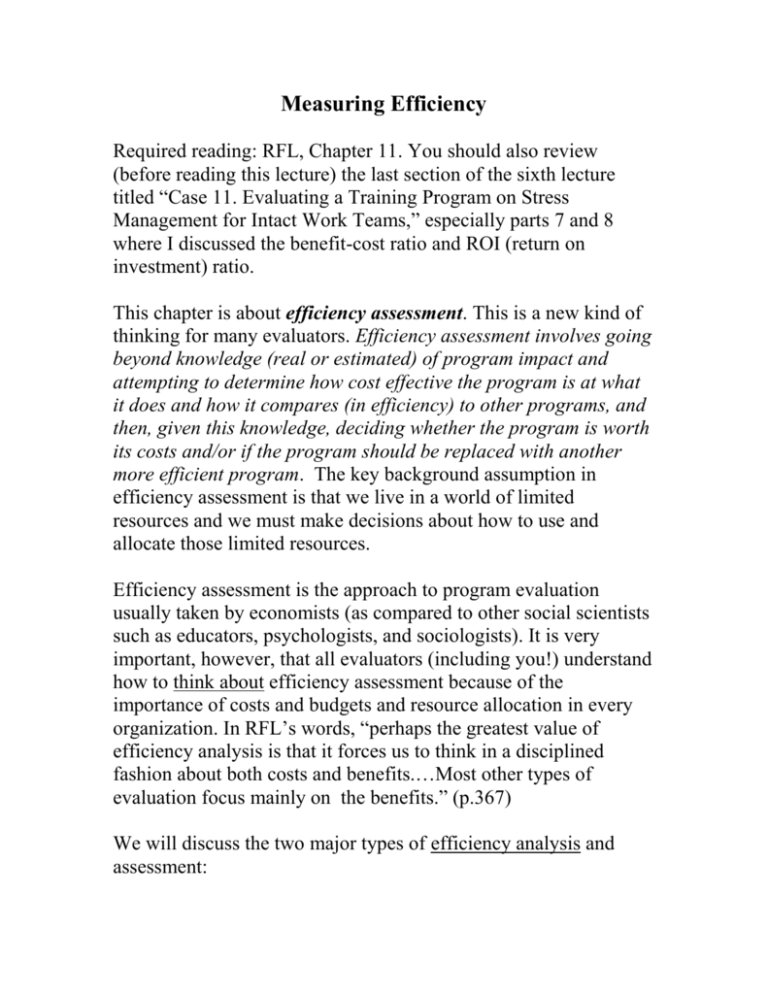
Measuring Efficiency Required reading: RFL, Chapter 11. You should also review (before reading this lecture) the last section of the sixth lecture titled “Case 11. Evaluating a Training Program on Stress Management for Intact Work Teams,” especially parts 7 and 8 where I discussed the benefit-cost ratio and ROI (return on investment) ratio. This chapter is about efficiency assessment. This is a new kind of thinking for many evaluators. Efficiency assessment involves going beyond knowledge (real or estimated) of program impact and attempting to determine how cost effective the program is at what it does and how it compares (in efficiency) to other programs, and then, given this knowledge, deciding whether the program is worth its costs and/or if the program should be replaced with another more efficient program. The key background assumption in efficiency assessment is that we live in a world of limited resources and we must make decisions about how to use and allocate those limited resources. Efficiency assessment is the approach to program evaluation usually taken by economists (as compared to other social scientists such as educators, psychologists, and sociologists). It is very important, however, that all evaluators (including you!) understand how to think about efficiency assessment because of the importance of costs and budgets and resource allocation in every organization. In RFL’s words, “perhaps the greatest value of efficiency analysis is that it forces us to think in a disciplined fashion about both costs and benefits.…Most other types of evaluation focus mainly on the benefits.” (p.367) We will discuss the two major types of efficiency analysis and assessment: Benefit-Cost Analysis and Assessment. Cost-effectiveness Analysis and Assessment. You will need to understand both of these approaches, the ways of thinking, and the related terminology. There is a nice list of related terminology on page 365 of the chapter. Benefit-Cost Analysis and Assessment In benefit-cost analysis, monetary (i.e., dollar) values are estimated for the resources used (i.e., costs) and for the program effects (i.e., benefits), and these two components (costs and benefits) are then compared to determine the worth of a program. In RFL’s words, benefit-cost analysis involves “determining the economic efficiency of a program, expressed as the relationship between cost and outcomes, usually measured in monetary terms.” Key Idea 1: Benefit-cost analysis can be carried out according to different perspectives, and you will need to select a perspective when conducting a benefit-cost analysis. The major point is that the results of a benefit-cost analysis will vary according to the perspective taken. In some cases, the evaluator may wish to take more than one perspective for comparative purposes. Here are three common accounting perspectives: 1. 1. When using the individual or target perspective, the costs and benefits are listed that relate to the individuals in the program. This would be the perspective taken by an individual participating in a program. For example, a cost to someone attending a training seminar might be the opportunity cost of the time spent in the seminar (e.g., foregone earnings) if the employer does not compensate him or her. A benefit might be higher earnings in the future. To get total benefits you sum all of the individuals’ benefits; to get total costs, you sum all of the individuals’ costs. 2. 2. When using the program sponsor perspective, the costs and benefits are listed that relate to the program sponsor. This is the perspective taken in business; it is also the perspective taken by non-profits and government for many decisions. In business, the term profit is used when benefits are greater than costs. A couple of costs to a company conducting a seminar would be the payment to an outside trainer and any lost production while company employees attend the training event. A benefit for the company might be increased job satisfaction and greater worker productivity (which, by the way, would be difficult to turn into dollar values). 3. 3. When using the communal or society or national government perspective, the costs and benefits are listed that relate to the community or society. This is the broadest perspective and it is frequently taken by members of the federal government. For example, if a program is done with individuals who are less advantaged, you might give an increased future income benefit a higher than normal weight (e.g., weighting the benefit by a factor of 1.5 rather than by the standard weight of 1.0). In general, programs are highly regarded when they have large impacts relative to costs, when they positively affect many people while having few negative impacts (direct or indirect), when they have positive distributional effects (e.g., reducing income or wealth inequality), and when they improve the conditions of groups that are having difficulty in the normal economic system (e.g., job and skills training for people who have been laid off, educational programs for young welfare recipients, and programs for children born into poverty who start far behind everyone else). This perspective includes a large dose of utilitarianism, while at the same time protecting individual and minority rights. Some programs may not show positive net dollar benefits but still should be provided (e.g., public goods such as parks and roads and programs for severely disabled individuals). Comparative benefit-cost and comparative cost-effectiveness analyses (i.e., analyses comparing different programs) provide important information to be used in deciding which program in a set of programs should be selected and funded. Ultimately, however, the division of the federal budget is a political action. Key Idea 2: The evaluator must list all costs and benefits and then quantify these costs and benefits. The costs and benefits need to be converted to dollar units, and any benefits or costs occurring in the future must be discounted (i.e., converting them to their present value). The present value in this context is the value of a future benefit or cost in present dollar values (e.g., in year 2002 dollar values). (See Exhibit 11-H for a good explanation of the discounting process. Spread-sheet programs such as Lotus 123 make discounting relatively easy to perform.). Benefits are especially hard to quantify. (Later in this lecture I will point out that this is why a cost-effectiveness analysis may be preferred over a benefit-cost analysis.) RFL discuss several approaches that can be used for quantifying benefits (i.e., money measurements, market valuation, econometric estimation, hypothetical questions, and observing political choices). You should list all benefits and costs that cannot be quantified in the final evaluation report so that the reader can interpret the results in light of this information. Furthermore, you may also want to make several different sets of calculations based on different assumptions (e.g., assume a discount rate of 3% for one scenario, 5% for the second, and 10% for the third). Ultimately you must determine the costs and benefits of a program and then make a comparison. First, you can form a benefit-cost ratio which is the total dollar benefits divided by the total dollar costs, where any costs and benefits that may occur in the future are in converted to their discounted or present values. A benefit-cost ratio of 1 is the break even point; a benefit-cost ratio that is less than one means that the costs are greater than the benefits; a benefit-cost ratio that is greater than one means that the benefits are greater than the costs (i.e., the desired result). A second way to compare the costs and benefits is to subtract the total costs from the total benefits and determine the net benefits. If the net benefits is positive, the benefits are greater than the costs, and if net benefits is negative, the costs are greater than the benefits. A nice feature of reporting net benefits is that it shows the net benefits in dollar amount. A third way to relate costs and benefits is to calculate the ROI or return on investment index. The return on investment index is popular in business and it is a measure of the profit made by the program calculated as a percentage of money spent on the program. It is calculated as follows: (a) subtract total costs from the gross or total benefits and (b) divide the number resulting from step “a” by the total costs. Here it is as a ratio: total benefits – total costs -----------------------------total costs (Note: You multiply the result by 100, or move the decimal place two places to the left, if you want a percentage rather than a proportion.) Looking at the formula you can see that the ROI is equal to net benefits (i.e., total benefits minus total costs) divided by total costs. Any value greater than zero on the ROI index indicates a positive return on your investment. Here are the results for three alternative but comparable programs. (To be comparable, the programs’ outcomes must be measured in the same outcome unit.) Use it to see how to calculate the three indices. Let’s say the three programs (Program A, Program B, and Program C) represent three alternative approaches to the prevention of dropping out of high school by adolescents: Results for three alternative interventions ------------------------------------------------------------A B C ------------------------------------------------------------Benefit per student $600 $500 $550 Cost per student Benefit/Cost ratio Net benefits ROI $300 $625 $360 2.0 0.8 1.5 $300 -$125 $190 1.0 -0.20 .53 Effectiveness Rank 1 3* 2 ------------------------------------------------------------*Program B costs more than it produces in benefits. This is reflected in the negative net benefits, the negative ROI, and a B/C ratio that is less than one. I strongly recommend that you do your own calculations to make sure that you can calculate the benefit-cost ratio, net benefits, and ROI (Hint…Hint.). Key Idea 3: There is an important distinction between two types of benefit-cost analysis that is based on the time at which the data are collected in relation to the program. First, a prospective benefit-cost analysis (or ex ante analysis) is done before or during the planning or development of a program (i.e., before the program is fully operational). Obviously in this case you must estimate the cost and benefit ingredients (including likely or program impact) in order to conduct the benefit-cost analysis. Prospective analysis is important in helping decision makers to decide whether to develop a full-fledged version of a program idea or to abandon the program idea. It can also help in making decisions about whether to modify a program or not. RFL make a strong case that more prospective benefit-cost assessments need to be carried out, because, among other reasons, once a program is put into operation, it can be politically difficult as well as expensive to dismantle. The key point is that before spending money, one should consider the potential benefits and costs. Second, a retrospective benefit-cost analysis (or ex post analysis) is done as a follow-up to an impact assessment (i.e., after a program has been observed in operation and program impact has been measured). This type of analysis is important in deciding whether an existing program that has a net impact is worth its costs. It is essential to understand that not all programs that show positive impact should be retained. As an analogy, in traditional research, we are taught not to assume that a statistically significant finding is necessarily useful or is practically significant. In short, knowledge of program impact is not enough information for decision making. Key Idea 4: Another important distinction in efficiency analysis is whether one is interested in absolute or comparative questions. I will label these absolute benefit-cost analysis, which is used to determine whether the benefits are greater than the costs for a single program, and comparative benefit-cost analysis, which is used to determine how two or more programs (or components of a program) compare to one another on efficiency grounds (i.e., which one has the greatest benefits in relation to costs?) Key Idea 5: Let’s put together the ideas we have discussed into the steps that are carried out in a benefit-cost analysis. First, here are the steps in an absolute benefit-cost analysis: 1. 1. Select an accounting perspective to use for the analysis (e.g., select the participant perspective, the program sponsor perspective, or the communal perspective). 2. 2. List the relevant costs (including opportunity costs and externalities) and benefits of the program. Also make any relevant distributional considerations if taking the communal perspective (e.g., conduct separate analyses for different groups and use weights for costs or benefits that reduce inequality). 3. 3. Determine or estimate the dollar values of the costs and benefits of the program. 4. 4. Calculate the benefit-cost ratio (i.e., dollar benefits divided by dollar costs), net benefits (i.e., dollar benefits minus dollar costs) and/or the return on investment index. 5. 5. Make a decision about the usefulness or worth of the program (or prospective program) and make your evaluative judgment and recommendations. Second, here are the steps in a comparative benefit-cost analysis: 1. 1. Select an accounting perspective to use for the analysis (e.g., select the participant perspective, the program sponsor perspective, or the communal perspective). 2. 2. List the relevant costs (including opportunity costs and externalities) and benefits for each of the programs being compared. Also make any relevant distributional considerations if taking the communal perspective (e.g., conduct separate analyses for different groups and use weights for costs or benefits that reduce inequality). 3. 3. Determine or estimate the dollar values of the costs and benefits for each of the programs being compared. 4. 4. Calculate the benefit-cost ratio (i.e., dollar benefits divided by dollar costs), net benefits (i.e., dollar benefits minus dollar costs), and/or the return on investment index for each of the programs being compared. 5. 5. Make a decision about the usefulness or worth of the program (or prospective program) in relation to the other comparable programs and make your evaluative judgment and recommendations. Cost-Effectiveness Analysis and Assessment Cost-effectiveness analysis is based on cost and effect data (rather than cost and benefit data as in benefit-cost analysis). In RFL’s words, in cost-effectiveness analysis the evaluator determines “the efficacy of a program in achieving given intervention outcomes in relation to the program costs.” This might sound a little abstract, but what it means is that you turn the costs in to dollar units (which is usually easy to do) but you do not attempt to turn benefits into dollar units (which is often very difficult to do). You leave the primary benefit in the natural outcome units in which it is measured (e.g., number of decreased school absences due to a program or number of days, on average, that clients stay off drugs as a result of a program). Most of the earlier discussion about benefit-cost analysis is directly applicable to cost-effectiveness analysis. The key difference is that you only focus on one or a few benefits and the benefit(s) is not converted to dollar values. Just as was the case for benefit-cost analysis, cost-effectiveness analysis can be absolute or comparative (called absolute costeffectiveness analysis and comparative cost-effectiveness analysis). Also, cost-effectiveness can be done prior to or after development of a program (called prospective cost-effectiveness analysis and retrospective cost-effectiveness analysis). Costs that occur in the future must be discounted, just like in benefit-cost analysis. Cost-effectiveness involves determining the cheapest way of doing something or determining how much “bang for the buck” you get from a program. Because we live in a world of limited or scarce resources, we should choose programs that produce large outcomes and have low costs. In other words, we should choose efficient programs. Here are the steps in cost-effectiveness analysis: I. Determine the costs and effects for the program (and any other comparison programs). You develop a list of the ingredients required for the program and the amount of each that is used. Also include any relevant opportunity costs and externalities. Some examples of program costs are personnel, facilities, and equipment and materials costs. You must next determine the dollar value of each of the costs. Costs may differ depending on the accounting perspective taken. For example, budgetary costs from one perspective may exclude volunteer costs and costs of donated equipment, which will be included as costs in other peoples' budgets. Now that you have determined the dollar value of the costs, you simply need to add up the costs to determine total costs. The measures of net effect come from an impact assessment (in a retrospective cost-effectiveness analysis) or they are estimated (in a prospective cost-effectiveness analysis). II. Determine the cost-effectiveness ratios for alternative programs that produce the same kind of output. The costeffectiveness ratio is the outcome or effect produced by the program divided by the cost. The smaller the cost effectiveness ratio the better the value or efficiency of a program. Here is a table showing the hypothetical results for three alternative interventions (e.g., three drug treatment programs for high school students). Results for three alternative interventions ------------------------------------------------------------A B C ------------------------------------------------------------Effects per student 15 25 35 Cost per student $300 $925 $350 Cost/effect ratio $ 20 $ 37 $ 10 Rank 2 3 1 ------------------------------------------------------------- As you can see, Program C has the smallest (i.e., best) costeffectiveness ration. The cost of each unit of output is the lowest for Program C. Program B is the least cost effective because each unit of output is the most expensive. Note that you can frame the cost-effectiveness question in two ways. A. You can select the program that costs the least per unit of outcome (as done above) by selecting the program with the smallest cost-effectiveness ration. In other words, you are interested in which program uses the least bucks (i.e., dollars) for a fixed amount of bang (i.e., output). or B. You can select the program that yields the largest outcome per dollar of cost. In other words, you are interested in which program provides the largest “bang for the buck” (i.e., the most output per dollar spent). If you prefer this second way of thinking, you use an effect/cost ratio (i.e., effects divided by costs) rather than a costeffectiveness ratio (i.e., costs divided by effects). Here is an example based on our earlier data where, this time, programs are compared using an effect-cost ratio: ------------------------------------------------------------A B C ------------------------------------------------------------Effects per student 15 25 35 Cost per student $300 $925 $350 Effect/cost ratio .05 .027 .1 Rank 2 3 1 ------------------------------------------------------------- You can see that Program C provides the most output per dollar spent (i.e., it provides .1 units of output per dollar spent) and Program B produces the least output per dollar spent (i.e., it provides .027 units of output per dollar spent). III. Make a decision about the usefulness or effectiveness of the program (or a prospective program) in relation to the other comparable programs. This is where you make your summative judgment and recommendations. In conclusion, you may wonder “Why would one want to conduct a cost-effectiveness analysis rather than a benefit-cost analysis?” The answer is because it is difficult to convert many kinds of benefits to dollar units and, therefore, cost-effectiveness analysis is more practical and less controversial. Cost-effectiveness analysis is useful because it requires evaluators to consider the often neglected issue of cost and it allows evaluators to compare the efficiency (e.g., cost per unit of output) of different programs.

